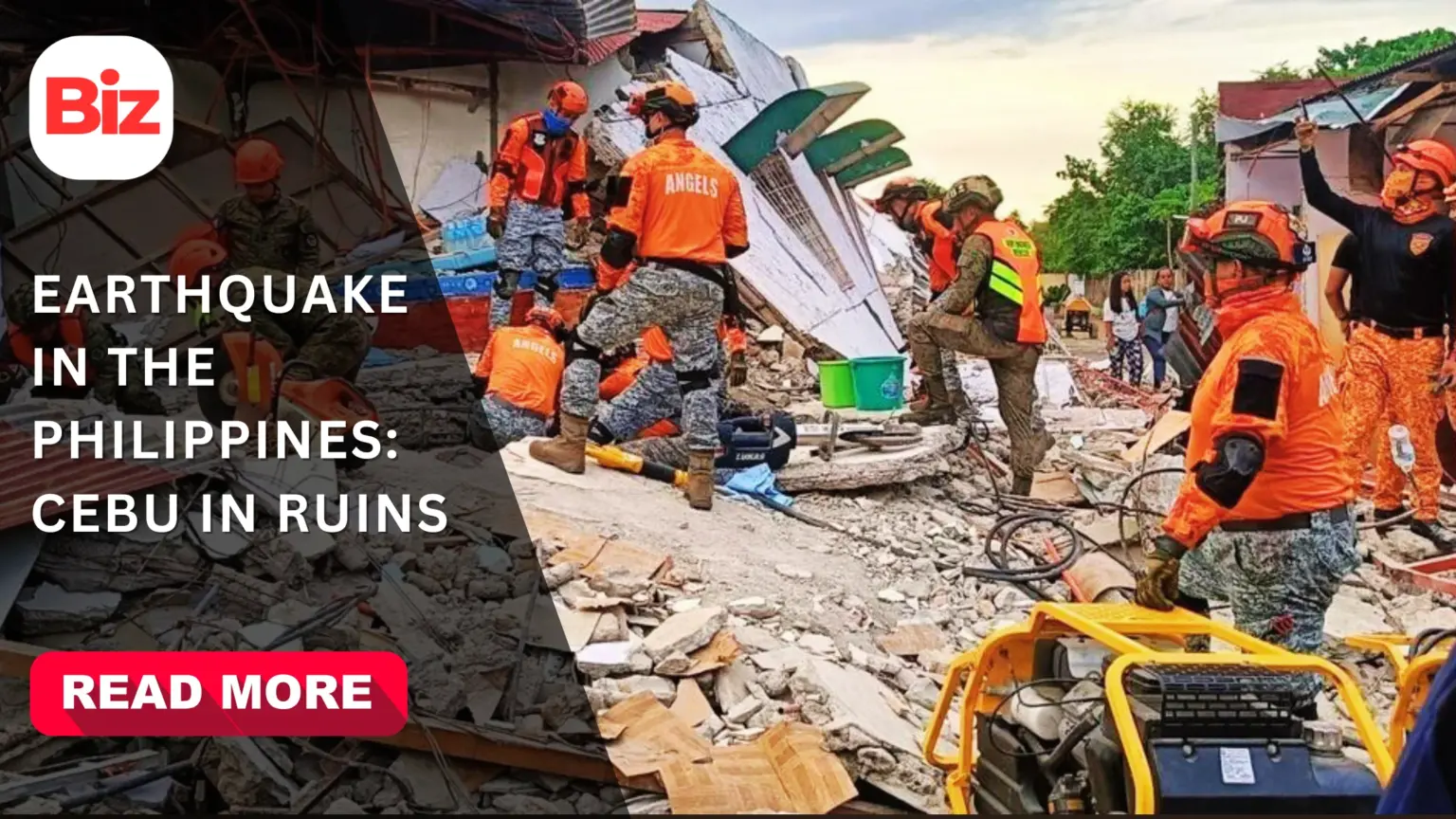A typical evening was being experienced by the people, a humming refrigerator, a streetlight and the soothing whine of a fan, when night fell in the Philippines on September 30th. Coming hotfooting up against 10 o’clock, a devastating shock shattered the peace, marking yet another earthquake in the Philippines.
Entire neighborhoods in northern Cebu were completely ruined and in the aftermath, grief-stricken families were left without a home, with thousands of others homeless. Rescue teams methodically combed the area from house to house, digging by hand and calling out names in the dark in the hope of hearing an answer.
Seismologists measured a 6.9 magnitude quake with its epicenter off the coast near Bogo City, and the focus lay roughly five kilometres beneath the seabed, a relatively shallow depth that meant the impact was felt strongly in the coastal towns and resulted in the disaster being far more deadly than initially estimated.
As the death toll rose, confirmed fatalities and those who were injured were recorded by local and national authorities and rescue teams battled through the rubble. By October 2, official counts confirmed at least 72 people had lost their lives, thousands were displaced, hospitals in Cebu found it difficult to keep up with the flood of patients, and power failures reduced the speed of the rescue work.
Why the Quake Turned So Deadly
What turned this event into such a calamity was not one, single reason, but rather a deadly combination of factors. Coming just as people were drifting off to sleep, the shallow depth of the quake, heavy downpours from the previous tropical storm had made the slopes prone to landslides and these, in turn, combined to make the strong temblor into a tragedy for many communities.
Cebu felt the violence in ways that are painfully visible; this Cebu earthquake will live in local memory. In Bogo and neighbouring towns, houses and small commercial buildings pancaked. A sports complex in San Remigio partly collapsed during a packed basketball match; spectators and first responders caught inside suffered fatal injuries. Centuries-old churches — the region’s memory-laden landmarks — dropped in clouds of dust, taking with them relics and the familiar outlines of civic life. Landslides blocked roads and left the upland villages isolated.
Night-time collapses increase casualties. People asleep indoors have less chance to flee; they are more likely to be trapped by falling masonry. Darkness also complicates immediate response. In this quake, many towns lost power right away, forcing rescuers to search with flashlights and phone torches amid unstable ruins.
The human picture is stark. More than twenty thousand people moved into evacuation centres or temporary shelters. Local authorities declared a state of calamity so they could unlock emergency funds and coordinate relief more rapidly. Food distribution lines formed near gymnasiums that had become makeshift reception centres.
Hospitals and Rescue Challenges
Hospitals became the busiest places. The provincial hospital in Bogo and district clinics took in the worst injuries. Some wards overflowed, and medics set up triage tents. The Philippine Red Cross and other aid groups sent field teams and emergency supplies. But with bridges cracked and roads blocked by landslides, delivering help to remote neighbourhoods took precious time.
Aftershocks followed. Several measured above magnitude 4, and a few were strong enough to keep residents on edge. Each tremor sent people back into the open. Engineers warned that buildings shaken by the main shock could collapse later if inspectors did not check them carefully.
Beyond the immediate rescue phase, questions about resilience surfaced fast. Why did so many homes collapse? How many structures met modern building codes? Initial assessments pointed to a mix of weak construction, unreinforced masonry, and the age of some buildings. Recovering safely will mean not just replacing roofs and walls but rebuilding with stronger standards and honest enforcement.
The quake rekindled a national anxiety about larger threats. Scientists have long warned that Metro Manila sits atop active faults capable of producing a “Big One”. Such a quake would be much larger and could have catastrophic potential. Seeing cities and towns in Cebu flattened in hours sharpened the question: are Philippine cities prepared for the really big shocks? Officials said lessons from Cebu must guide upgrades in the capital and other vulnerable regions.
Relief Efforts and Community Response
Relief efforts expanded after the first day. The national government dispatched additional emergency teams and equipment. Local volunteers and community groups collected food, clothing and tools. Universities, churches and civic organisations converted halls into reception centres. Social media feeds filled with pleas for help and lists of donation sites. International aid offers followed while NGOs coordinated with government agencies on distribution.
That coordination faces practical hurdles. With tens of thousands affected, the logistics are complex. Shelters need sanitation, clean water and food. Damaged clinics require medicines and stable power. Schools that open as evacuation centres must remain safe for children while serving as spaces of recovery. Officials warned that without quick support, these secondary crises can grow in the days after the quake. Sickness, lack of access to care and dehydration were particular concerns.
Among the quiet stories of the disaster are small acts that steadied communities. Neighbours dug by hand to free those trapped beneath timber and concrete. Fishermen loaned boats to reach isolated coves. Community leaders organised lists of vulnerable households so relief teams could find them faster. Those acts, repeated across dozens of barangays, saved lives and kept panic from swallowing entire towns.
Loss of Heritage and Identity
Cultural losses cut deep. In many towns, churches are more than places of worship; they are communal memory banks. Centuries-old bell towers and convents that had watched generations were gone in minutes. Those ruins are not just stone and wood. They are anchors of identity. Rebuilding them will require money, skill and patient choices about how to preserve heritage while making structures safer.
This was not just an isolated tremor. It became another painful chapter in the long story of the earthquake in the Philippines. Families in coastal barangays wondered how quickly they could rebuild roofs or repair wells. Local governments faced urgent, heavy choices about shelters, transitional housing and the safe disposal of rubble. NGOs and volunteers will be central to the recovery. Community mental-health teams are in demand to help children and adults process sudden loss and fear.
This earthquake in Cebu will be remembered for neighbourly rescues and for the gaps relief systems must fill. People told how a whole barangay shared food until formal aid arrived. That communal resilience will matter when formal aid runs into bottlenecks. And across the ocean, planners in Metro Manila observed closely; a serious earthquake in Manila could inflict far greater losses without urgent preparedness measures. For now, Cebu’s work is repair and consolation. For the nation, it is a reminder: build stronger, plan smarter, and protect the most vulnerable first.
The Road Ahead
The road to recovery will be long. Clearing debris, reestablishing roads and repairing water lines takes time. Many families will need temporary housing for months. Economic losses will ripple through local markets that depend on daily trade and tourism. Small businesses — sari-sari stores, guesthouses, tricycle operators — felt the hit almost immediately. Restoring livelihoods matters as much as rebuilding homes.
Policy-wise, the Cebu quake creates pressure for change. Experts urge stricter enforcement of building codes, retrofitting of schools and hospitals, and better mapping of landslide-prone slopes. Public education must expand. People need to know where to go during tremors. They must also secure heavy furniture and keep evacuation plans ready. These are inexpensive but effective measures.
The archipelago will continue to shake; the earthquake in the Philippines that struck Cebu is a clear reminder. Living with that reality asks for two things: humility and action. Humility because no engineering or policy can prevent earthquakes. Action because better planning and community strength can reduce their toll. For Cebu’s survivors, the immediate task is simple and urgent: shelter, clean water and safe food. For the nation, the task is broader: build back stronger.
The scars will shape a generation. Children who sleep in tents tonight will remember. Parents who lost a home will remember. The choices made now — in rebuilding, in policy, in community care — will determine future resilience. They will decide whether next time a quake comes, the story reads differently.
Recommended For You
Global Sumud Flotilla: Recent Developments, Interception & Global Reactions








